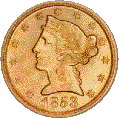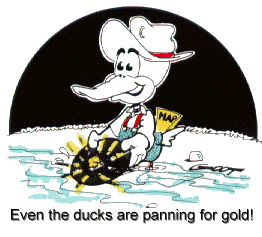Gold Facts and History page!
 Dahlonega Georgia Gold Coins |
GOLD COINS |
 Charlotte North Carolina Gold Coins |
| At right, Gold in some of it's many forms. From the gem and mineral collections of the Smithsonian's National Museum of Natural History. Photo by Dane A. Penland © 1992 Smithsonian Institution. |
 |
|
|
At left, beautiful leaf gold from the Red Ledge Mine in California's Mother lode region. It was photographed by Bob Jones at Kristalle in Laguna Beach, California. This picture appeared in the January, 1992 issue of ROCK & GEM magazine |
| At right, a 7 inch high, 454.7 gm gold nugget from the Eureka Mine of Tuolumne Co. California. From the gem and mineral collections of the Smithsonian's National Museum of Natural History. Photo by Dane A. Penland © 1992 Smithsonian Institution. |
 |
PRICES
![[Click here to get the most recent Quotes from www.kitco.com]](http://www.kitconet.com/images/quote_fixes.gif)
Symbol: Au from the latin Aurum
Atomic Weight: 197.2
Atomic Number: 79
Melting point: 1063 deg. C.
Hardness(Moh): 2.5
Specific Gravity: 19.3, Thats 19.3 times the weight of an equal volume of water and why it settles to the bottom of your gold pan.
Gold is very malleable, meaning it can be hammered into very thin sheets. Gold is also very ductile, meaning it can be drawn out into a very thin wire without breaking. Just 52 ounces of gold was used to cover (gild) the dome of Georgia's capital building. One ounce can cover 150 square feet of area. One pound of gold can make a wire 1/20,000 of an inch in diameter, reaching from Atlanta Ga. to San Antonio, Texas
First, a little history and background information. Gold is one of the first metals known to be used and prized by man. It was probably first, primarily because it occurs naturally in a usable form. Other metals, such as lead, tin and copper, did not seem to inspire the same passions and desires.
Because gold resists the actions of naturally occurring chemical processes, objects made from it not only last forever, but hold their beauty as well. Other materials may have been used more extensively than we have evidence for, but have been lost due to natural forces destroying them. Traces of metal objects are often found as oxides and in forms that are hard to confirm as even being man made.
Gold has been so prized that it was, at one point in time, used extensively as currency. Many countries today still use it to partially back up their national currencies and produce limited numbers of gold coins. In the past, gold reached values over $600 ($675.30 in Jan of 1980)an ounce, but today is often above $1300.
On the plus side, the demand for gold remains high and historically has held its value. Today the uses for gold include not only the traditional coins, jewelry etc. but also include being used in the manufacturing of electronics and for foil shields in the space program.
Gold has even been eaten as a thin foil around candy.
![]()
For up to date infomation on current
gold related activities and prices, go to
The Privateer
![]()
A very informative site with tons of gold related site links, can be found at
GOLDSHEET
Check it out!
![]()
This site has terrific information and is intertaining too! It may not be in the Southeast, but worth the visit
Gold Prospectors of Colorado
![]()
MAPS
A great source of information, and maps of your area is BIG TEN'S Maps. They can be found on the web at
http://goldmaps.com


![]()
Other sources of maps (but not just gold sites)
Maps by
![]()
Microsoft Expediamaps
The U.S. Geological Survey
Mayhill Press
Mapville
California Interactive Maps
Pathfinder Maps
The University of Georgia Map Collection
The University of Texas Map Collection
More Map Links
![]()
![]()
Want to find something on the web?
Type what it is (in the space below)
and press the ENTER key

Lycos catalog *
TOP 5%
TO MY HOME PAGE
TO MY LINKS PAGE
